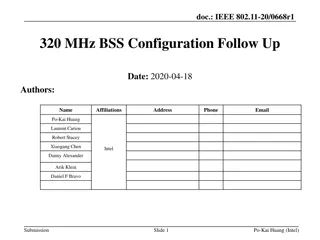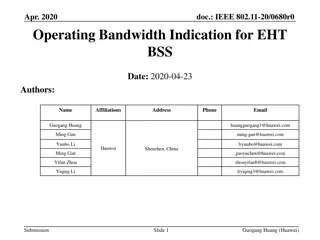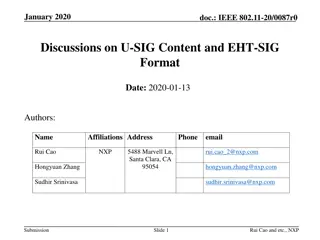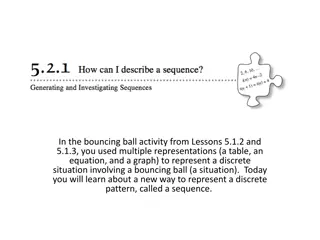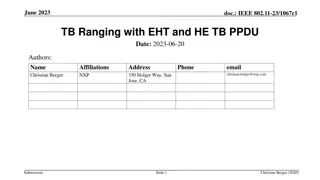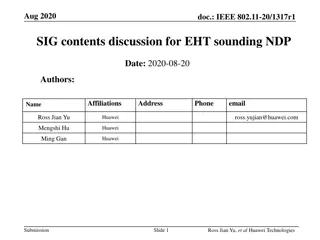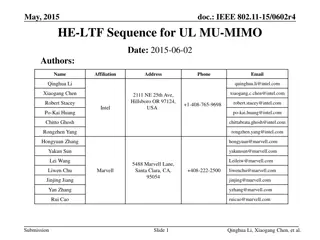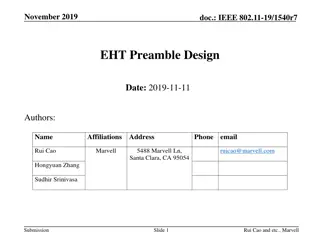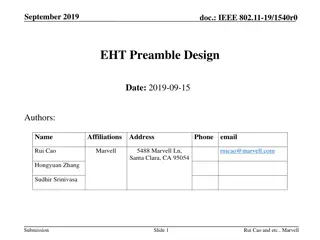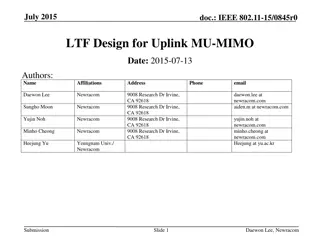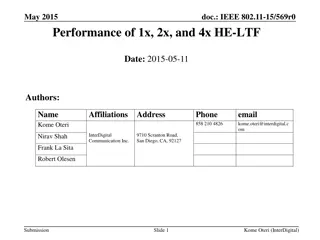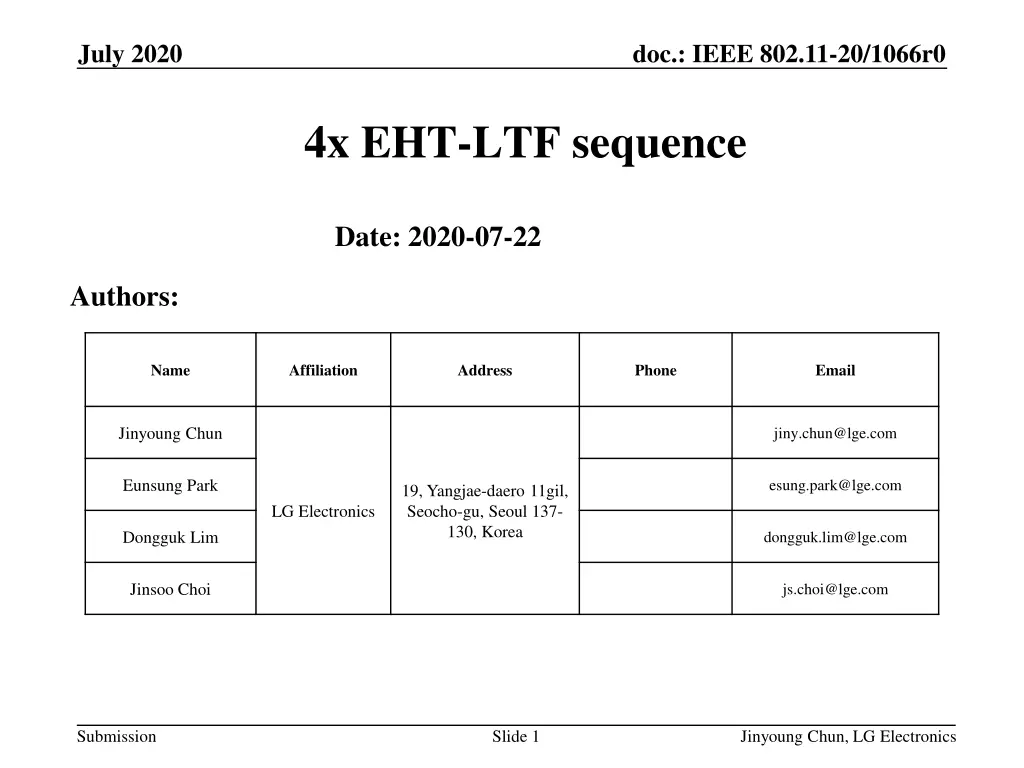
Optimizing EHT-LTF Sequences for IEEE 802.11-20 Transmission
Explore the optimization of 4x EHT-LTF sequences for IEEE 802.11-20 transmission modes at different MHz segments. Suggestions are provided for both Option 1 and Option 2 configurations, aiming to enhance performance and minimize PAPRs. Detailed insights and generation methods are outlined for effective implementation.
Download Presentation

Please find below an Image/Link to download the presentation.
The content on the website is provided AS IS for your information and personal use only. It may not be sold, licensed, or shared on other websites without obtaining consent from the author. If you encounter any issues during the download, it is possible that the publisher has removed the file from their server.
You are allowed to download the files provided on this website for personal or commercial use, subject to the condition that they are used lawfully. All files are the property of their respective owners.
The content on the website is provided AS IS for your information and personal use only. It may not be sold, licensed, or shared on other websites without obtaining consent from the author.
E N D
Presentation Transcript
July 2020 doc.: IEEE 802.11-20/1066r0 4x EHT-LTF sequence Date: 2020-07-22 Authors: Name Affiliation Address Phone Email Jinyoung Chun jiny.chun@lge.com Eunsung Park esung.park@lge.com 19, Yangjae-daero 11gil, Seocho-gu, Seoul 137- 130, Korea LG Electronics Dongguk Lim dongguk.lim@lge.com Jinsoo Choi js.choi@lge.com Submission Slide 1 Jinyoung Chun, LG Electronics
July 2020 doc.: IEEE 802.11-20/1066r0 Introduction I suggested EHT-LTF sequences for 320MHz [1]. I generated 1/2/4x EHT-LTF sequences based on HE-LTF sequence, but 2/4x LTF has somewhat high PAPRs in some RUs. So here I considered the further optimization of 4x EHT-LTF sequence. Submission Slide 2 Jinyoung Chun, LG Electronics
July 2020 doc.: IEEE 802.11-20/1066r0 4x EHT-LTF sequence according to transmission mode There are two options Option1: 320MHz 4x EHT-LTF sequences are used for 320MHz OFDMA/non- OFDMA transmission and 240MHz OFDMA/non-OFDMA transmission together. The below RU sizes are considered. 26, 52, 52+26, 106, 106+26, 242, 484, 242+484 in 80MHz segment, 996, 484+996 in continuous 160MHz, 2*996 in continuous 160MHz, 3*996, 3*996+484, 4*996 as well as 2*996, 2*996+484 Option2: 320MHz 4x EHT-LTF sequences are used for 320MHz OFDMA/non- OFDMA transmission only. The below RU sizes are considered. 26, 52, 52+26, 106, 106+26, 242, 484, 242+484 in 80MHz segment, 996, 484+996 in continuous 160MHz, 2*996, 3*996, 3*996+484, 4*996 If we choose option2, we need to define 240MHz 4x EHT-LTF sequence, too. Then the below RU sizes are considered. 26, 52, 52+26, 106, 106+26, 242, 484, 242+484 in 80MHz segment, 996, 484+996 in continuous 160MHz, 2*996, 3*996, 2*996+484 In this slide, EHT-LTF sequences for both options are suggested. Submission Slide 3 Jinyoung Chun, LG Electronics
July 2020 doc.: IEEE 802.11-20/1066r0 4x EHT-LTF sequence generation(1/2) Case 1: 4x EHT-LTF sequence based on HE-LTF sequences of 40MHz subchannel I suggested 4x EHT-LTF sequences in [1]. But I found the sequences with 1 stream. Here I re-select the sequence with multi-stream as below. But as I said, any combinations based on LTF80MHz_left/right_4xcan t put all PAPRs under data s median in 4x LTF. EHTLTF320MHz_4x = {LTF80MHz_lower1_4x, 23 zeros, LTF80MHz_upper1_4x, 23 zeros, LTF80MHz_lower2_4x, 23 zeros, LTF80MHz_upper2_4x} LTF80MHz_lower1_4x = {n(1)*LTF80MHz_left_4x, 0, n(2)*LTF80MHz_right_4x} LTF80MHz_upper1_4x = {n(3)*LTF80MHz_left_4x, 0, n(4)*LTF80MHz_right_4x} LTF80MHz_lower2_4x = {n(5)*LTF80MHz_left_4x 0, n(6)*LTF80MHz_right_4x} LTF80MHz_upper2_4x = {n(7)*LTF80MHz_left_4x, 0, n(8)*LTF80MHz_right_4x} LTF80MHz_left_4x, LF80MHz_left_4x are in 11ax n(1)~n(8) = [1 -1 -1 -1 -1 1 1 1] for option1, [1 1 1 1 1 -1 -1 1] for option2 Submission Slide 4 Jinyoung Chun, LG Electronics
July 2020 doc.: IEEE 802.11-20/1066r0 4x EHT-LTF sequence generation(2/2) Case 2: 4x EHT-LTF sequence based on HE-LTF sequences of 20MHz subchannel Divide LTF80MHz_left/right_4x {1:500} in units of 20MHz subchannel and apply different coefficients in each subchannel as below. It's also aligned with the RU unit of new 80MHz segment in 11be. EHTLTF320MHz_4x = {LTF80MHz_lower1_4x, 23 zeros, LTF80MHz_upper1_4x, 23 zeros, LTF80MHz_lower2_4x, 23 zeros, LTF80MHz_upper2_4x} LTF80MHz_lower1_4x = {n(1)*LTF80MHz_left_4x_1, n(2)*LTF80MHz_left_4x_2, 0, n(3)*LTF80MHz_right_4x_1, n(4)*LTF80MHz_right_4x_2} LTF80MHz_upper1_4x = {n(5)*LTF80MHz_left_4x_1, n(6)*LTF80MHz_left_4x_2, 0, n(7)*LTF80MHz_right_4x_1, n(8)*LTF80MHz_right_4x_2} LTF80MHz_lower2_4x = {n(9)*LTF80MHz_left_4x_1, n(10)*LTF80MHz_left_4x_2, 0, n(11)*LTF80MHz_right_4x_1, n(12)*LTF80MHz_right_4x_2} LTF80MHz_upper2_4x = {n(13)*LTF80MHz_left_4x_1, n(14)*LTF80MHz_left_4x_2, 0, n(15)*LTF80MHz_right_4x_1, n(16)*LTF80MHz_right_4x_2} LTF80MHz_left_4x_1 = LTF80MHz_left_4x{1:250} LTF80MHz_left_4x_2 = LTF80MHz_left_4x{251:500} LTF80MHz_right_4x_1 = LTF80MHz_right_4x{1:250} LTF80MHz_right_4x_2 = LTF80MHz_right_4x{251:500} n(1)~n(16)= [1 -1 1 -1 1 -1 -1 1 1 1 -1 -1 1 1 1 1] for option 1 and [1 1 -1 1 -1 1 1 1 1 1 1 -1 -1 1 -1 -1] for option 2 Submission Slide 5 Jinyoung Chun, LG Electronics
June 2020 doc.: IEEE 802.11-20/1066r0 PAPR performance (1/3) PAPRs of Small (M)RUs It shows some fluctuation because HE-LTF sequence is not optimized with RU units of 11be 80MHz tone plan, but mostly are lower than Data median. PAPRs of Large (M)RUs In option1, the worst PAPRs of Case1 and Case2 are 10.12dB and 9.5dB, respectively. The second value is below Data s median. Submission Slide 6 Jinyoung Chun, LG Electronics
July 2020 doc.: IEEE 802.11-20/1066r0 PAPR performance (2/3) Submission Slide 7 Jinyoung Chun, LG Electronics
July 2020 doc.: IEEE 802.11-20/1066r0 PAPR performance (3/3) Submission Slide 8 Jinyoung Chun, LG Electronics
July 2020 doc.: IEEE 802.11-20/1066r0 Analysis of PAPR results Case 1 and Case 2 Many PAPRs of case1 are higher than Data s median. But most PAPRs of case2 sequence are under Data s PAPR. The worst PAPRs of Case1 are 10.12dB in Option1 and 9.55dB in Option2, and in Case2, 9.5dB in Option1 and 8.91dB in Option2. So I prefer Case2. Option1 and option2 in Case2 The worst PAPRs of option1 are 9.5dB in 320MHz and 240MHz transmission. And the worst PAPRs of option2 are 8.91dB in 320MHz transmission and 9.35dB in 240MHz transmission (See Appendix). We slightly prefer option1 because PAPRs of option1 is lower than data s median and there is no big gain with two separated sequences. Submission Slide 9 Jinyoung Chun, LG Electronics
July 2020 doc.: IEEE 802.11-20/1066r0 Conclusion I showed the cases to make 4x EHT-LTF sequence for 320MHz as well as 240MHz Case1 is to use HE-LTF as it is and Case 2 is to use HE-LTF with more coefficients. We can t catch Data s PAPRs with Case 1, and so I prefer Case2. And there are two options in each case Option1 is the best sequence for 240MHz and 320MHz transmission. It means, RU combination of 2*996+484RU is also considered with other RU sizes for 320MHz transmission, and the option2 is the best sequence for only 320MHz transmission. We can choose a option if 240MHz channelization or transmission is defined. But we can consider option1 regardless the decision because the performance of option 1 in case 2 is not bad in all RU sizes. Submission Slide 10 Jinyoung Chun, LG Electronics
July 2020 doc.: IEEE 802.11-20/1066r0 Reference [1] IEEE802.11-20/0825r1, EHT-LTF sequences considering new tone plan Submission Slide 11 Jinyoung Chun, LG Electronics
July 2020 doc.: IEEE 802.11-20/1066r0 Straw poll 1 Do you agree to add the below text in SFD? In 320MHz transmission, 4x EHT-LTF sequence is given as below. EHTLTF-2036,2036= {LTF80MHz_lower1_4x, 0, 0, 0, 0, 0, 0, 0, 0, 0, 0, 0, 0, 0, 0, 0, 0, 0, 0, 0, 0, 0, 0, 0, LTF80MHz_upper1_4x, 0, 0, 0, 0, 0, 0, 0, 0, 0, 0, 0, 0, 0, 0, 0, 0, 0, 0, 0, 0, 0, 0, 0, LTF80MHz_lower2_4x, 0, 0, 0, 0, 0, 0, 0, 0, 0, 0, 0, 0, 0, 0, 0, 0, 0, 0, 0, 0, 0, 0, 0, LTF80MHz_upper2_4x} Where LTF80MHz_lower1_4x = {LTF80MHz_left_4x_1, -LTF80MHz_left_4x_2, 0, LTF80MHz_right_4x_1, -LTF80MHz_right_4x_2} LTF80MHz_upper1_4x = {LTF80MHz_left_4x_1, -LTF80MHz_left_4x_2, 0, -LTF80MHz_right_4x_1, LTF80MHz_right_4x_2} LTF80MHz_lower2_4x = {LTF80MHz_left_4x_1, LTF80MHz_left_4x_2, 0, -LTF80MHz_right_4x_1, -LTF80MHz_right_4x_2} LTF80MHz_upper2_4x = {LTF80MHz_left_4x_1, LTF80MHz_left_4x_2, 0, LTF80MHz_right_4x_1, LTF80MHz_right_4x_2} LTF80MHz_left_4x_1 = LTF80MHz_left_4x{1:250} LTF80MHz_left_4x_2 = LTF80MHz_left_4x{251:500} LTF80MHz_right_4x_1 = LTF80MHz_right_4x{1:250} LTF80MHz_right_4x_2 = LTF80MHz_right_4x{251:500} Y/N/Abs Submission Slide 12 Jinyoung Chun, LG Electronics
July 2020 doc.: IEEE 802.11-20/1066r0 Appendix. 240MHz 4x EHT-LTF 4x EHT-LTF sequence for 240MHz transmission Case1 EHTLTF320MHz_4x = {LTF80MHz_lower1_4x, 23 zeros, LTF80MHz_middle_4x, 23 zeros, LTF80MHz_upper_4x} LTF80MHz_lower_4x = {n(1)*LTF80MHz_left_4x, 0, n(2)*LTF80MHz_right_4x} LTF80MHz_middle_4x = {n(3)*LTF80MHz_left_4x, 0, n(4)*LTF80MHz_right_4x} LTF80MHz_upper_4x = {n(5)*LTF80MHz_left_4x, 0, n(6)*LTF80MHz_right_4x} n(1)~n(6)= [1 1 1 -1 -1 -1] Case2 EHTLTF320MHz_4x = {LTF80MHz_lower_4x, 23 zeros, LTF80MHz_middle_4x, 23 zeros, LTF80MHz_upper_4x} LTF80MHz_lower_4x = {n(1)*LTF80MHz_left_4x_1, n(2)*LTF80MHz_left_4x_2, 0, n(3)*LTF80MHz_right_4x_1, n(4)*LTF80MHz_right_4x_2} LTF80MHz_middle_4x = {n(5)*LTF80MHz_left_4x_1, n(6)*LTF80MHz_left_4x_2, 0, n(7)*LTF80MHz_right_4x_1, n(8)*LTF80MHz_right_4x_2} LTF80MHz_upper_4x = {n(9)*LTF80MHz_left_4x_1, n(10)*LTF80MHz_left_4x_2, 0, n(11)*LTF80MHz_right_4x_1, n(12)*LTF80MHz_right_4x_2} n(1)~n(12)= [1 -1 -1 1 1 1 -1 -1 1 -1 1 -1] Submission Slide 13 Jinyoung Chun, LG Electronics
July 2020 doc.: IEEE 802.11-20/1066r0 Appendix. PAPR CDF of Data parts Submission Slide 14 Jinyoung Chun, LG Electronics

